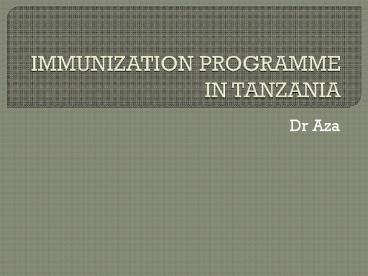IMMUNIZATION PROGRAMME IN TANZANIA PowerPoint PPT Presentation
1 / 17
Title: IMMUNIZATION PROGRAMME IN TANZANIA
1
IMMUNIZATION PROGRAMME IN TANZANIA
- Dr Aza
2
Introduction
- The Expanded Programme on Immunization (EPI) in
the country started in 1975 with the aim of
reducing morbidity and mortality caused by
measles, poliomyelitis, whooping cough, tetanus
and tuberculosis in children under 5 years of
age. - The programme is currently involved in delivering
safe vaccines for vaccine preventable diseases to
under one and women of child bearing age and/or
populations at risk.
3
- The programme also involves procurement of
vaccines, supplies and equipment from the
manufacturer/suppliers to the point of vaccine
administration in a recommended condition. - In the process of delivering vaccines,
appropriate storage and transport facilities are
important issues of the programme.
4
Vaccine-preventable diseases
- Vaccine preventable diseases in Tanzania that are
currently addressed by immunization programme
include - ?? Polio,
- ?? Measles,
- ?? Neonatal Tetanus,
- ?? Diphtheria,
- ?? Pertusis,
- ?? Tuberculosis
- ?? Hepatitis B.
5
- The current available vaccines in the programme
are - Bacille Calmette-Guerin(BCG)
- Oral Polio Vaccine(OPV)
- Diptheria-Pertusis- Tetanus-Hepatitis B(DPT-HB)
- Measles vaccines and
- Antitetanus toxoid for pregnant women
6
Programme financing
- Programme receives funds from GAVI(Global
Alliance for Vaccines and Immunization), Central
government and other partners such as UNICEF,
WHO, JICA, DANIDA, Ireland Aid, USAID, Rotary
international and the Basket Fund.
7
Programme organization and management.
- The Expanded Programme on Immunization is under
the Reproductive and Child Health Section, which
belongs to the Directorate of Preventive Services
of the MOH(Ministry of Healthy). - At the national level there is a Programme
Manager who is the overall in-charge of the
programme. - The programme comprises of four sections, which
are Monitoring, Training, Administration and Cold
Chain/Logistics.
8
At National(central)level
- The role of the Programme at Central level is to
formulate policy guidelines and standard and
guidelines on immunization strategies for
immunization, planning and budgeting, training,
procurement and storage of vaccines, supplies and
equipment, distribution, monitoring and
evaluation. - The Central level is also vested with the role of
managing the resources i.e. storage, distribution
facilities, and equipment.
9
At regional level
- At this level, the programme is under the
Regional Medical Officer (RMO) who is being
assisted by Regional Cold Chain Officer (RCCO)
and Regional MCH(Mother and Child
Health)Coordinator. - Their functions include planning and budgeting,
storage, distribution, monitoring and
supervision, training, technical support and
management of resources of immunization
activities at regional level.
10
At district level
- At the district, the District Medical Officer
(DMO) is the in-charge of the programme and is
being assisted by the District Cold Chain Officer
(DCCO) and the District MCH Coordinators. - Their roles include planning and budgeting for
immunization activities, storage and
distribution, monitoring and supervision,
facilitating the implementation, training and
providing technical support to the facilities.
11
Program performance
- Immunization Schedules
- There are two immunization schedules currently in
use. The first schedule is targeting to children
under one year of age and the second is for women
of childbearing age, that is, 15-49 years.
12
Under one year
ANTIGEN SCHEDULE
BCG At birth
OPV0 At birth
DPT-HB1,OPV1 Four weeks
DPT-HB2,OPV2 Eight weeks
DPT-HB3,OPV3 Twelve weeks
Measles Nine month
13
Child bearing age
ANTIGEN SCHEDULE
TT1 Any time at first contact
TT2 One month after the first visit(TT1)
TT3 Six months after TT2
TT4 One year after TT3
TT5 One year after TT4
14
Programme constraints
- In the implementation of immunization activities,
there are various constraints, which affect the
performance and sustainability of the program.
These constraints include - 1.Inadequate funds for funding all planned
activities - 2.Delay in disbursement of funds from both
government and Development partners.
15
- 3.Receiving fewer funds as compared to pledges
from different sources. - 4.Delays in the procurement process.
- 5.Lack of adequate and qualified staffs
especially at the facility level.
16
EPI Strategies 2007-2015
- To Strengthen the delivery of safe and effective
vaccine. - To have adequate monitoring system supplies and
performance. - To support hard to reach/low coverage districts
- To strengthen outreach services
- To involve local governments in planning
- To ensure availability of CFC free cold chain
equipments by 2010. - To ensure proper coordination between EPI and
other partners - To strengthen managerial capacity at national
level. - To strengthen reporting system at all level
- To strengthen active surveillance for polio
measles at all levels. - To ensure implementation of mass campaign for
measles control and polio eradication. - To ensure polio free status is maintained.
- To strengthen community surveillance
- To establish hib/pneumococci/rota disease burden.
17
- Thank you for your attention

